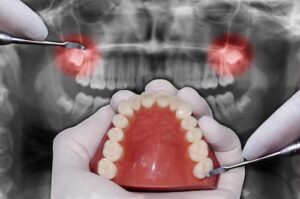Wisdom Teeth Removal
 Your dental health affects how healthy your body is overall. We put a lot of effort into maintaining the health of your teeth and gums at our dental clinic. Our goal is to provide you with exceptional treatment at a reasonable cost. Our sites provide extractions as one of the full tooth replacement options. Our dentists will remove your tooth if they believe it to be the best option for you. We take into account a number of variables, including your age, the state of the tooth in issue, and any past restoration treatment, to help you make the best decision.
Your dental health affects how healthy your body is overall. We put a lot of effort into maintaining the health of your teeth and gums at our dental clinic. Our goal is to provide you with exceptional treatment at a reasonable cost. Our sites provide extractions as one of the full tooth replacement options. Our dentists will remove your tooth if they believe it to be the best option for you. We take into account a number of variables, including your age, the state of the tooth in issue, and any past restoration treatment, to help you make the best decision.
The presence of a tooth that has been worn down by decay, which can spread infection to nearby healthy tissue, may exacerbate the pain and suffering. A damaged tooth shouldn’t compromise your oral health. We offer tooth extractions that successfully relieve pain. This crucial operation both lessens discomfort and stops the illness from spreading.
The doctor will use a local anaesthetic to numb the tooth, jaw bone, and gums close to the extraction site. You will feel a lot of pressure while the extraction is being done. This is the consequence of the procedure when the tooth is vigorously shaken to open the socket and prepare it for removal. You sense the pressure without feeling any pain because the anaesthetic has numbed the nerves and stopped pain from being sent, but the nerves that transfer pressure are untouched. Please let us know right away if you experience any pain while having the tooth extracted.
Sectioning a Tooth
Some teeth require splitting. When a tooth is so firmly fixed in its socket or the root is so curved that the socket cannot enlarge sufficiently to remove it, this is a fairly common procedure. The tooth is easily separated into parts, and our dentist removes each portion individually.
After Tooth Extraction
A blood clot must form after a tooth extraction in order to halt the bleeding and initiate the healing process. Chew on a piece of gauze for 30 to 45 minutes after your visit. If the bleeding or seeping continues, place another gauze pad over the area and keep biting hard for another 30 minutes.
You can have some discomfort and swelling following the extraction of the tooth. Applying an ice pack, a bag of frozen peas or corn, or an unopened bag of frozen peas to the afflicted region can all help to decrease swelling. Exactly as directed, take painkillers. After 48 hours, the puffiness often disappears.
Exactly as directed, take painkillers. If the drug isn’t appearing to be working as it should, kindly contact our office. Even after the signs and symptoms of illness have faded, keep taking antibiotics for the time recommended if prescribed. Eat nutritious, soft meals and drink a lot of water the day before the extraction.
You can continue eating regularly as soon as you feel at ease. After a 24-hour break, you should get back to your usual dental schedule. At least once a day, brushing and flossing are recommended for healthy teeth. You’ll recover faster and keep your tongue in good condition if you do this.
At our dental practice, we have extracted the wisdom teeth of thousands of patients, enhancing or restoring their look and functionality.
